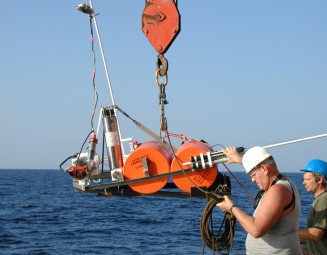Formation and evolution of continental shelves, passive margins, ocean basins and ocean islands

I am a marine geophysicist who analyses seismic, magnetic and gravity data to determine the structure of the crust and upper mantle in a variety of tectonic settings. The aim of this research is to understand the relationship between magmatism and tectonics.
[See here for Jenny Collier's shallow-water research]
Return to Jenny Collier's homepage
The projects labelled *** CURRENT *** are ones I am actively working on. Please email me if you are interested in joining my group or would like further information.
Research projects
What is the magma plumbing system beneath a Mid-Ocean Ridge like?
Mid-Ocean Ridges are geologically important because they occur along divergent plate boundaries, where new ocean floor is created as the Earth's tectonic plates spread apart. They represent the longest and most significant chain of volcanoes on our planet, yet due to their remoteness remain relatively poorly studied. Establishing the details of the magmatic plumbing system beneath these features is needed in order to understand how melt is delivered from the mantle to form new oceanic crust. I have completed a number of projects that used seismic data to determine the size and molten state of magma chambers beneath the southern and northern East Pacific Rise.
- Feeling the pulse: time-lapse seismic at the East Pacific Rise *** CURRENT ***
- Melt-to-mush: Size and molten state of axial magma chambers
- Porosity and permeability of young upper oceanic crust
How are Ocean Islands formed?
Whilst most volcanic activity happens at plate margins, there are cases of volcanoes erupting in the middle of plates. When these erupt on oceanic lithosphere and breach sealevel they are usually known as "Ocean Islands". In the classic model, the magmatism is caused by a deep-seated mantle plume, that forms a chain of age-progressive islands as the plate moved over it. Alternate models suggest that fragments of continental crust may lie at the cores of some island groups. I have investigated these ideas at two sites, the Canaries in the Atlantic Ocean and the Seychelles in the Indian Ocean.
Do mantle plumes cause continental breakup?
A key question in the study of volcanic continental margins is whether their temporal-spatial pattern of magmatism is caused by mantle plumes (temperature and/or composition anomalies in the mantle) or by enhanced mantle flow. We are investigating these relationships through a combination of seismic interpretation (active source wide-angle and reflection) and finite element modelling. Current collaborations include ION-GX (South Atlantic) and NAG-TEC (North Atlantic).
- Structure of the Seychelles-Indian passive margins
- Magmatism and breakup in the South Atlantic *** CURRENT ***
How does water cycle through subduction zones?
Subduction zones are the locations of the largest exchange of material from the surface to the deep Earth. However, currently we have little information on the passage of volatiles through this system, and have been unable to attempt any form of mass balance to estimate how much of it enters the deep interior. Fundamental questions such as: what is the distribution of water in the down-going plate, how is slab dehydration distributed with depth and variable along strike, how does dehydration affect flow in the subduction mantle wedge, and what controls the location of the volcanic arc are unanswered.
- Volatile recycling at the Antilles subduction zone *** CURRENT ***
People
- Jenny Collier
- Zofia Zalai (PhD student)
- Rob Allen (PhD student)
- John Armitage (now at IPG, Paris)
- James Hammond (now at Birkbeck, University of London)
- Richard Davy
- Carl McDermott (PhD student, graduated)
- Chandra Taposeea (PhD student, graduated)
- James Hammond (PhD student, graduated)
- Victoria Sansom (PhD student, graduated)
- Chris Lane (PhD student, graduated)
- Rupert Dalwood (PhD student, graduated)
External collaborators
- Helene Carton (IPG, Paris)
- John Armitage (IPG, Paris)
- Tim Henstock (Southampton)
- Mike Kendall (Oxford)
- Tim Minshull (Southampton)
- Andreas Rietbrock (Liverpool)
- Satish Singh (IPG, Paris)
- Tony Watts (Oxford)
- Bob Whitmarsh (NOC)
Funding
I am grateful to the following bodies for funding this work:
NERC, EU, Royal Society, BP, ION-GX